The Land Of China -- Explore by Province
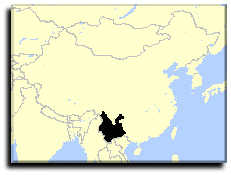 |
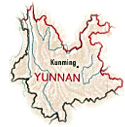 |
Yunnan

|
The Stone Forest and the Dianchi Lake are Yunnan's key attractions, along with many other interesting sites worth visiting.
Kunming, the City of Spring
Kunming, the capital of the Yunnan Province is the political, economic, and cultural center of the province as well as its transportation and communication hubs. It is a famous historical city of the country and an international trade and tourist city towards south and southeast Asia.
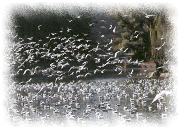
|
The city is beautifully situated on the 330-square-kilometer Dianchi Lake, China's sixth largest, and is surrounded by mountains. On the Western Hills are the 14th-century Huating Temple, Taihua Temple, and Sanqing Tower, once a summer resort of an emperor. The Dragon Gate has stone corridors and intricate carvings cut from the 17th century. 18 kilometers northwest of Kunming is the Qiongzhu (Bamboo) Temple, with 500 lively life-size arhats. The Stone Forest of Lunan is 80 kilometers away. The Anning (Peaceful) Springs has hot springs containing calcium, magnesium and sodium.

|

|
Dali stands in the west against Cangshan Mountain and in the east adjoins Erhai lake. It is embraced and encircled by undulating hills. Abundant sunshine makes the weather warm, but the wind is very strong and explains how Xiaguan of Dali got the name of "A Town of Wind". Dali has a long history. As early as 4,000 years ago, the ancestors of the Bai and Yi nationalities had already occupied the areas around Dali. They created the Erhai Culture and left numerous and brilliant historical cultural relics.
Cangshan Mountain and Erhai Lake are the most famed scenic spots in Dali, and are reputed as the "Snow-Covered Cangshan Moutain and Jade-Green Erhai Lake". Cangshan Moutain stands erect like a huge screen, and under the fleecy clouds, its snow-capped pinnacles and the stream that flows in between make a beautiful picture. The placid and crystal-clear Erhai lake comprises the following famous scenic spots: the Three Islets, the Sand Bars, the Five Miniature Lakes, and the Nine Curvantures. The wind, flowers, snow, and moon make a perfect natural picture that renders this ancient city with even more attractiveness. People adorn it as "the Switzerland of the East."
Shilin, the Stone Forest
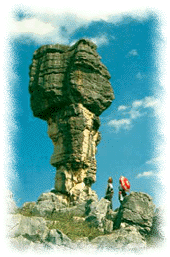
|
The Stone Forest, 80 kilometers away from Kunming, is located in the city's Yi nationality autonomous county of Lunan. With an area of over 350 square kilometers, it chiefly consists of 7 scenic spots, namely: the Big Stone Forest, the Naigu Stone Forest, the Dadie Waterfall, the Zhiuyun Cave, the Qifeng Cave, Long Lake, and Moon Lake. In the forest are many stone peaks, rock pillars, stone flours, rock levels, and rock flows of a thousand different shapes like a vast black forest. Therefore, it is known as "the first wonder in the world."
The Stone Forest is is made up of limestone formations known as karst. About 270 million years ago, the area was submerged and a thick layer of limestone was deposited on the bottom. The movement of the earth's crust caused the sea bottom to thrust upward and become land; through weathering and erosion over eons, the stone was moulded into pillars. From a distance, it looks indeed like a dense forest and is why it is called the Stone Forest. Known as" the most fantastic scenery under Heaven," it has a myriad of pinnacles that are of fanciful shapes taxing the imagination.
Lijiang
Lijiang a piece of mysterious land that lies in the northwest of Yunnan and on the south of the QingZang Plateau. The terrain is precipitous with imposing landscape and magnificent scenery. Lijiang is known as the Oriental Venice as sluggishly trickling rivers flow across the streets paved with colorful stone plank. Jade Peak Temple is one of seven lamaseries in which one can see luxuriant trees and impressive scenery. Here lives a 300-year-old camellia tree called the "Ten-thousand Camellia" which has over ten thousand blossoms every year.

|
Xishuang Banna
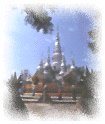
|
Xishuang Banna is situated in the south of Yunnan, 742 kilometers southwest of Kunming. The age old ethnic customs and lifestyle coupled with the picturesque natural beauty of the subtropical region will surely delight any tourist. It has a population of 690,000 people, including the Dai, Hani, Lahu, Bulang, Jinuo, Yao, Yi, and some other nationalities. It is endowed with sufficient sunshine and is usually windless and very warm, with heavy dews and fogs and plenty of rainfall. Xishuang Banna is one of the key scenic resorts of Yunnan. Points of interest are scattered in many locations of the prefecture, all with distincive features. The temples have intricate flaming roofs and snake designs, and near the border lives 300 wild elephants in a nature preserve. With its tropical rain forests, rare and precious oramental plants, and wild animals combined with its multifarious peculiar national customs and habits of the southerm country, Xishuang Banna has always been a cherished tourist resort for vistors at home and abroad.
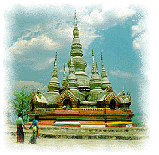
|
The Mengla Tropical Plantation is also known as the Yunnan Provincial Research Institute of Tropical Plants. It is located on Huludao Island, northwest of Mengla County. Covering an area of 130 hectares, it was established in 1958. The garden has more than 1,500 kinds of plants from home and abroad including cash crop plants, wild plants and ornamental plants. Among them are the upas trees, devipepper, dracaena cambodiana trees and other remarkable Chinese medicinal herbs, rare forest trees, oil crops and tropical or subtropical fruits. As a research centre of Chinese tropical plants, it has had more than 120 kinds of research results in tropical plant resources and the introduction, domestication and artificial propagation of fine varieties.
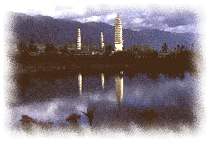
|
The White Pagodas of Manfeliong at Damenglong are situated in a place 67 kilometers south of Jinghong (which is in South Yunnan). The whole structure is composed of nine big and small pagodas, all in the shape of a calabash. The bodies of the pagodas are white in color, whereas the tops are all golden. The tallest pagoda measures 16.3 meters in height. The nine pagodas were all built on an octagonal foundation, and at the bases of the eight small pagodas are round niches, in and around which there are carvings of all kinds of animals, shrubs, and flowers, all in bas-relief. They look magnificent and grand, typifying the architectural style of the Dai people and their religious cstoms.
the Dai Village at Manjinglan
The Dai Village at Manjinglan is about one kilometer southeast Jinghong. The bulidings here have unique characteristics of their own, for they are all built in the form of stilted bamboo houses surrounded by railings. Different households are paritioned off by bamboo hedges, forming individual compounds. In the compounds are evergreen gardens. Manjinglan is at the same time a commercial street where delicacies of Dai flavor are served. Just go up a stilted bamboo house any time, and the hospitable host will entertain you with foods prepared in the Dai style, which may be sour, hot, bitter, sweet, fragrant, or crisp in various combinations. Here one can also learn about the daily life and religious customs of the Dai people by watching and even taking part in the performances of their folk dances.



 Chinese Culture
Chinese Culture